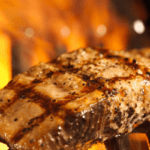Salmon is one of the easiest fish to grill, and it can produce some of the best results if you shop wisely and prepare the fish and the grill properly. Many fish tend to be flaky and delicate, but salmon is more robust, with a fattiness that keeps it from drying out during cooking.
How to Choose Salmon Fillets for Grilling
Cooking wild or farm-raised salmon on the grill is both possible, although farm-raised salmon is more consistently fatty, which can work to your advantage when cooking over such dry heat. We also have compiled a guide that will help you choose the other best fish for grilling.
Grilling wild salmon is more likely to succeed if you get thicker, fatter fillets. Size and fattiness of wild salmon depend on species and the time of year they were caught, so you may not have a lot of control over what you get.
No matter whether the fish is wild or farm-raised, the thicker the fillet, the better. With more thickness, you get more time for the skin to crisp while the heat of the grill penetrates and cooks the fillet. Even if you don’t want to serve salmon at that level of doneness, thinner pieces are more likely to be cooked through and well done by the time the skin crisps up.
This means that you should buy center-cut fillets, which come from the thicker part of the fillet, not from the tail end, which tapers into a thinner, more irregularly shaped piece. Salmon can vary greatly in size, particularly if it’s wild, but the center-cut fillet on most farm-raised fish is usually one-and-a-half to two inches thick, which is ideal. That gives you lots of room to brown and crisp the exterior while achieving a rare or medium cook in the center.
If at all possible, you should also look for skin-on fillets. In the intense, dry heat of the grill, the skin acts as a natural insulator, protecting the flesh from overcooking. By doing this, you can spend more time cooking the skin side, crisping it to a crispiness of potato chips without completely overcooking the flesh just below.
In terms of portion sizes, I recommend getting six- to eight-ounce portions of fish pre-portioned. Furthermore, raw fish is much easier to portion out than cooked fish-once cooked, it does not cut as cleanly into individual servings-and smaller fillets are easier to flip over than large slabs of meat.
How to Grill Salmon Fillets
Prepare Your Grill
Grilling salmon fillets follows the same basic best practices as grilling anything else. Then, preheat your grill and grill grate, clean the grate well with a grill brush, and oil the grate. The hot, clean, and oiled grill grate will be much less likely to severely stick to your fish than the dirty, cold one.
It will likely take about the same time to cook your salmon over high heat to crisp the skin and sear the fleshy side, but you may want a cooler area available just in case the fillet tends to burn a bit longer. This means you need to set up your grill with a two-zone fire, which lets you place the fish over the hot coals, but still move it off to the side if it’s browning too quickly.
Prepare the Salmon Fillets
You can prepare your fish while your grill is preheating. By using paper towels to dry the salmon well on both sides, you will speed up the searing process and reduce the risk of the salmon sticking to the grill. After drying the fillets, I like to lightly rub them with a neutral oil like canola or vegetable oil. It’s just one more way to protect against sticking.
Grill the Salmon Skin Side Down
The salt slowly draws moisture out of proteins like fish and meat, so I sprinkle it on the salmon just before grilling it. Having dried the fish well, the last thing we want to do is get it wet again before grilling it.
Place the salmon skin side down on the grill before cooking. Cooking will be done primarily on this side since, as described above, the skin insulates the flesh from the heat and gives it plenty of time to dry and crisp.
With all the grill prep and fish prep we’ve done, there’s a good chance the skin will stick at first, but once it’s ready, it should release fairly easily. Since there are so many variables to account for (the heat of the coals and the distance of the grill grate above them being two major ones), you’re probably looking at a cooking time of about four minutes for the skin.
A lot of people are curious about the white substance that sometimes clots on the surface of fish. Fish albumen is a sign that the fish is overcooked. Due to the high dry heat on the grill, it’s almost impossible to completely avoid it, so don’t worry if you see a little of it form. You can wipe it away and continue.
Flip the Fish Over and Finish!
Proceed with caution when you think the salmon is ready to be flipped. Avoid sliding a thin metal spatula under it, which is almost guaranteed to tear the skin. Alternatively, slide the tines of a carving fork or the long prongs of culinary tweezers between the grill grate and the fish so that they’re below the fish. You can now use a prying motion to detach the skin from the grate by lifting gently.
Roll the fillets over, using a metal spatula to catch them on the other side and gently lower them down.
Cook the fish on the fleshy side only long enough to reach your desired internal temperature: 110°F (43°C) for rare, 120°F (49°C) for medium-rare, or 130°F (54°C) for medium.
Should your fish burn on the outside before it reaches its final internal temperature, move it to the cooler side of the grill to finish cooking. The skin should be crackling-crisp and blistered in places, while the interior should be moist and silky. That shouldn’t be too difficult if you follow these instructions.
Was this helpful?
Hi there! I’m a food enthusiast and journalist, and I have a real passion for food that goes beyond the kitchen. I love my dream job and I’m lucky enough to be able to share my knowledge with readers of several large media outlets. My specialty is writing engaging food-related content, and I take pride in being able to connect with my audience. I’m known for my creativity in the kitchen, and I’m confident that I can be the perfect guide for anyone looking to take their culinary journey to the next level.









